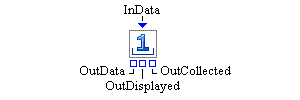
The Number Holder block is used to display a number that represents some user-defined state information. Values can be pushed to or pulled from a Number Holder block via its InData and OutData ports. A Number Holder block will automatically attempt to push any value received at its InData port out its OutData port. Similarly, when a request comes in to pull a value from the OutData port, a Number Holder block will, by default, attempt to pull a value from upstream using its InData port. The user can modify this default behavior using the Propagation controls on a Number Holder block.
By default a Number Holder block will display the last value to enter through its InData port, however options are available to display the minimum value, maximum value, mean value, sum of all values, or a count of how many values have entered the block.
The Number Holder block provides the capability of storing values that enter it using its data collection facility. This data can be saved to a SAS data set or JMP table. Values (along with time stamps) are stored in a DataModel object and the DataModel object can be accessed through the block’s OutCollected port. Display blocks, such as the Histogram block, are often connected to a Number Holder block’s OutCollected port to visualize the data. Any block using a DataModel object is automatically notified when the data in the DataModel object is modified.
If data collection is enabled, the InClearData port is also enabled on the Number Holder block. When a true Boolean value arrives at the InClearData port, it will be used as a signal to clear all the data collected by the Number Holder block up to that time during the simulation execution. If the InClearData port receives a false value, the signal will be ignored and data will not be cleared.
- Current
-
The last value to enter the Number Holder block. The value entered here will be displayed in the block (if the Display option is set to Value) until a new value enters the block.
- Default
-
The Default Value is used to initialize the Current Value in the Number Holder block when it is created or when the block is reset.
- Display
-
The drop-down box associated with the Display option controls what value is displayed on the Number Holder block. Options include the current Value, Minimum, Maximum, or Mean value, the Sum of all values, or the Count of how many values have entered the block.
- Propagation
-
The To Downstream check box is used to control propagation of values sent to the InData port of a Number Holder block. If this check box is selected any values entering the InData port will be automatically sent out the OutData port. Otherwise the value propagation will stop at the Number Holder block. If the From Upstream check box is selected any attempt to pull a value from the OutData port of a Number Holder block will result in the Number Holder block attempting to pull a value from block(s) connected to its InData port.
- Data Collection
-
The Collect Data check box is used to turn data collection on or off. The value entered in the Capacity field determines how many values are saved in the DataModel object. If the capacity is exceeded, a warning message is logged and values are overwritten in the DataModel object.
- Automatic Save
-
Turns on or off automatic saving of any collected data at the end of each design point replication run. If automatic saving is turned on, data are saved to a file with the base file name specified in the Base File Name field. Simulation Studio automatically determines the pathname of the folder for this file based on the pathname of the folder containing your saved project. If the Submit to Remote SAS Workspace Server option is selected, then any collected data are saved to a file on a remote SAS server. Simulation Studio automatically determines the pathname of the folder for this file on the remote SAS server using the Default File Path specified in the Simulation Studio Configuration dialog box.
- Save Now
-
Forces the Number Holder block to attempt an immediate save of any collected data. Data are saved to the same location as when automatic saving is turned on.
- Location
-
Displays the pathname of the folder for the file in which to save any collected data.
- Base File Name
-
Specifies the base file name for the SAS data set or JMP table that is used to save any collected data. This name will be the prefix of the actual file name. The zero-based index of the design point and the zero-based index of the replication number will be added as suffixes to the file name, separated by underscore characters. For example, the data for the first replication of the first design point will be saved in a file named
BaseFileName_0_0, and the data for the second replication of the first design point will be saved in a file namedBaseFileName_0_1.